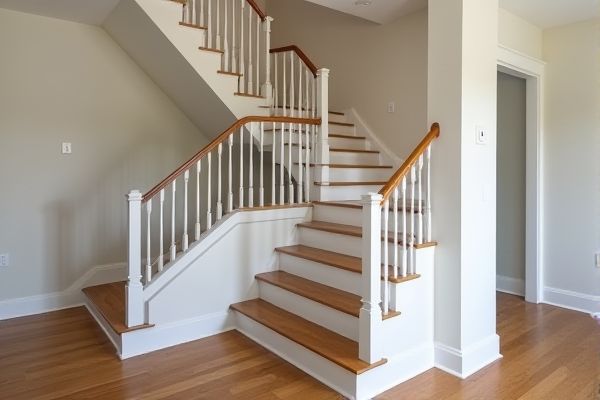
Wrap-around stairs maximize space efficiency and add architectural interest by turning 90 or 180 degrees, while straight stairs offer simplicity, ease of construction, and clear sightlines. Discover which stair design best suits your home's functionality and style needs by reading the rest of the article.
Table of Comparison
| Feature | Wrap-Around Stairs | Straight Stairs |
|---|---|---|
| Design | Curved or L-shaped, wraps around a landing or space | Linear, single straight flight |
| Space Efficiency | Maximizes corner or tight space use | Requires more linear length, less efficient in small areas |
| Installation Complexity | More complex; requires precise measurements and carpentry | Simple design ease installation |
| Cost | Higher due to complexity and materials | Generally lower cost |
| Safety | Safer landings reduce fall risk | Less forgiving; no landings increase fall risk |
| Aesthetics | Elegant, modern, adds architectural interest | Classic, minimalistic, functional |
| Usability | Offers resting points, easier for elderly | Continuous, less rest options |
| Common Applications | Residential, lofts, multi-level homes | Commercial buildings, simple home layouts |
Introduction to Staircase Design
Wrap-around stairs create a visually dynamic and space-efficient transition between floors, offering an elegant curvature that enhances architectural aesthetics. Straight stairs provide simplicity and cost-effectiveness, making them ideal for maximizing usable floor area and ease of construction. Both designs impact traffic flow and safety, influencing overall staircase functionality in residential and commercial buildings.
Overview of Wrap-Around Stairs
Wrap-around stairs feature a design that changes direction, typically turning 90 to 180 degrees, creating a visually dynamic and space-efficient solution for your home. These stairs combine functionality with aesthetic appeal by wrapping around a central point, often a landing or an architectural feature, making them ideal for compact layouts. Compared to straight stairs, wrap-around stairs offer enhanced safety with intermediate landings and smoother traffic flow between floors.
Overview of Straight Stairs
Straight stairs consist of a single, linear flight without changes in direction, making them the simplest and most space-efficient design. They typically require less construction time and materials compared to wrap-around stairs, which feature curved or angled turns. Commonly used in modern homes and commercial buildings, straight stairs provide easy navigation and clear sightlines, enhancing safety and accessibility.
Aesthetic Appeal Comparison
Wrap-around stairs offer a dynamic, elegant aesthetic that creates a sense of flow and spaciousness, often becoming a striking focal point in your home. Straight stairs provide a clean, minimalist look that emphasizes simplicity and modern design, suitable for narrow or compact spaces. Choosing between the two depends on whether you prioritize visual drama and architectural interest or straightforward functionality with sleek lines.
Space Utilization and Layout
Wrap-around stairs maximize space utilization by efficiently fitting into corners and making use of otherwise underutilized areas, creating a compact and visually dynamic layout. Straight stairs require more linear space but offer a simpler, more direct path ideal for narrow halls or long rooms. Your choice depends on whether you prioritize maximizing floor area or maintaining an open, streamlined design.
Safety and Accessibility Considerations
Wrap-around stairs provide enhanced safety by offering continuous handrails and wider landings, reducing the risk of falls during direction changes compared to straight stairs. Their design improves accessibility for individuals with mobility challenges by allowing gradual transitions and more resting points. When planning your home, choosing wrap-around stairs can create a safer, more user-friendly environment for all occupants.
Installation Complexity and Cost
Wrap-around stairs generally involve higher installation complexity due to their curved design and precise measurements, requiring skilled craftsmanship and specialized materials. Straight stairs are simpler and quicker to install, resulting in lower labor costs and fewer potential construction challenges. You can expect wrap-around stairs to demand a larger budget and longer installation time compared to the more cost-effective and straightforward construction of straight stairs.
Maintenance and Durability
Wrap-around stairs often require more maintenance due to their complex design, which includes multiple turns and joints that can accumulate dirt and wear faster than straight stairs. Straight stairs generally offer greater durability with fewer structural stress points, making them easier to clean and maintain over time. You can expect lower upkeep costs with straight stairs, but wrap-around stairs provide unique aesthetic appeal despite potentially higher maintenance needs.
Best Applications and Use Cases
Wrap-around stairs are ideal for spaces requiring a stylish, space-saving design, such as compact homes or areas with limited floor space. Straight stairs suit straightforward layouts with longer, unobstructed floor plans, commonly found in commercial buildings or modern residential designs. Your choice depends on spatial constraints and aesthetic goals, with wrap-around stairs offering a graceful flow and straight stairs providing simplicity and ease of navigation.
Choosing the Right Staircase for Your Home
Wrap-around stairs offer a visually dynamic design that maximizes space efficiency and adds architectural interest, ideal for homes with limited floor area or unique layouts. Straight stairs provide simplicity, ease of installation, and efficient movement, making them a practical choice for compact or traditional spaces. Your decision should balance aesthetic preferences, spatial constraints, and safety considerations to select the staircase that best complements your home's design and functionality.
 homyna.com
homyna.com